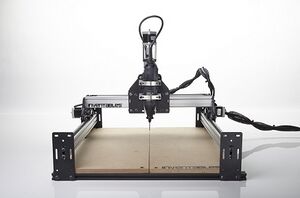Tools: ShapeOko 2
[This tool is no longer in service.]

Tool Description:
- Open source platform and components
- 11.5" wide x 13" deep x 2.5" high effective work volume. Some of the work piece will be off the machine's bed.
- The bed is 16" wide, and can accommodate a piece of unlimited length.
- Precision: X Axis 25μm, Y Axis 25μm, Z Axis 3.125μm
- Arduino Microcontroller
Materials (what to use, and not use, it on):
- Broad range of materials that may be worked (See materials and feed rates link below for details):
- Wood (successfully milled)
- Metal
- Plastic
- Composites
- Some Stones
- PCB
- Linoleum
- Corian
ShapeOko Wiki page on Materials and Feed Rates
General and Special Safety Considerations:
- Be safe --- wear appropriate safety equipment (esp. eyes (safety glasses/goggles), and ears (hearing protection --- at least foam ear plugs)), ensure clothing, hair and jewelry cannot become caught up in the machine. If necessary, arrange for dust collection and proper ventilation (if necessary, use respiratory gear suitable to the dust particles of the material being milled). Consider the possibility of the spindle starting a fire by friction and take suitable precautions (having a fire extinguisher handy, &c.).
- Check the machine (all bolts and set screws tight, belts tight and in good shape, wiring in good condition with continuity and nothing frayed or broken, everything clear and safe). The bolted down, inverted belts which result when using the belt anchor clips make this somewhat difficult --- use a mirror to examine the belts while moving the machine along its full range of movement.
- Secure the workpiece (right-side up and in the desired orientation) to the worksurface using a technique appropriate to the material (see Workholding).
- Mount an appropriate spindle and ensure that it is vertical and square to the machine and well-secured.
- Examine the End mill to ensure that it is sharp and in good condition and not chipped (this is best done with a loupe or magnifying glass), install it per the spindle manufacturer's directions, check to make certain that the collet is tight and will not work loose during operation (it needs to be more than hand-tight --- the machine will take no notice or care if it works loose). On the low-end rotary tools it may help to use a bit of plumber's Teflon thread tape on the collet.
- Ensure the work area is clear and all cables and wires run without interference. Especially check that there is nothing beneath the rails which might interfere with the wheels.
- If necessary, home the tool to the proper place in relation to the workpiece. (In the absence of limit switches, machine origin will be the location when Grbl powers up.)
- (optional) Traverse the working boundary of the job as a final check.
- Browse for the NC file which you have already simulated and send it to the machine.
- Monitor the machine while it operates, ensuring there is no build-up of dust, debris or fumes, and that nothing works loose, keeping clear of the work area. Once the job is complete, turn off the spindle, return the gantry to the home position, or a known offset from home (one may want to wait to turn off the spindle until it's been homed) and ensure the end mill has stopped spinning before removing the finished piece and any waste. Store endmills carefully when not in use so as to protect the edges. Collets and accessories should be cleaned between uses --- wiped off with a suitable solvent such as isopropyl alcohol.
- One should keep a log of machine usage and note when adjustments are made, or a fastener is (re)tightened, as well as keeping a tally of usage time, including for specific bits, so as to determine when parts need to be lubricated, or bits should be relegated to rough work or resharpened or recycled and replaced.
Note: Be careful to safely dispose of milling debris and dust, keeping in mind flammability, (potential) spontaneous combustion, and chemical considerations. Even natural materials can have surprising implications for disposing of them, e.g., walnut wood dust is aleopathic (inhibits plant growth) and an irritant to the skin and breathing tract and potentially poisonous to some animals in addition to the typical spontaneous combustion hazard which sawdust poses.
The content for this section is included from http://www.shapeoko.com/wiki/index.php/Operating_Checklist under the Creative Commons Attribution Share Alike copyright permission.
Tool Use:
- Use Easel (http://www.easel.com/) to design simple cuts, generate gcode, and control the ShapeOko.
- Other software may be better for complex designs.
Tips and Tricks:
- Wood or plastic panels can be positioned to prevent waste material from being thrown. This includes shielding the controlling laptop.
Related links:
Shapeoko 2 Safety and Operating Checklist